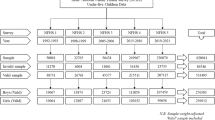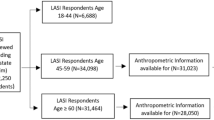Abstract
Introduction: Bolivia, as one of the poorest Latin American countries, has dealt with the problems of undernutrition for the last 50 y. Little importance has been given to the increase in overweight and obesity among the population, despite the scientific evidence linking overweight and obesity with mortality and morbidity.
Objective: To describe the social and demographic determinants of the nutritional status among women in Bolivia between 1989 and 1998 to gain a better understanding of the nutrition transition phenomena and to identify urgent research needs.
Methodology: Secondary analysis of the raw data of the Bolivian National Demographic and Health Surveys of 1994 and 1998. Changes in the prevalence of underweight, obesity and overweight are described by sociodemographic characteristics of Bolivian women. Social and demographic determinants of nutritional status have been fitted into a logistic model.
Results: The prevalence of overweight (defined as 25≤BMI<30 kg/m2) among women of reproductive age (20–44 y) increased by 9 percentage points between 1994 and 1998 (P<0.001), while the prevalence of normal BMI decreased by 10 percentage points (P<0.001). The decrease in the prevalence of underweight (defined as BMI <18.5 kg/m2) from 2.4% in 1994 to less than 1% in 1998 was statistically significant (P<0.001). Obesity (defined as BMI ≥30 kg/m2) was positively associated with geographical region (P=0.001), educational level (P<0.001), age (P=0.003) and total number of children (P=0.001) and negatively associated to rural locality (P=0.001) and native languages (P<0.001). Overweight was inversely associated with rural locality (P=0.013) and with Quechua language (P=0.04), while the total number of children (P<0.001) and year of survey (P<0.001) were positively associated. Underweight decreased dramatically (P<0.001), being positively associated with the region of residence (P=0.04) and inversely associated with the total number of children (P=0.006).
Conclusions: The present study suggests that the population of Bolivia is in a transitional stage, with overweight becoming as much of a problem as undernutrition.
This is a preview of subscription content, access via your institution
Access options
Subscribe to this journal
Receive 12 print issues and online access
$259.00 per year
only $21.58 per issue
Buy this article
- Purchase on Springer Link
- Instant access to full article PDF
Prices may be subject to local taxes which are calculated during checkout
Similar content being viewed by others
References
Anjos LA (1992): Body mass index (body mass.body height-2) as indicator of nutritional status in adults: review of the literature. Rev. Saude. Publica 26, 431–436.
Barcelo A, Daroca MC, Ribera R, Duarte E, Zapata A & Vohra M (2001): Diabetes in Bolivia. Rev. Panam. Salud. Publica 10, 318–323.
Bender R & Grouven U (1996): Logistic regression models used in medical research are poorly presented. BMJ 313, 628.
Bianchini F, Kaaks R & Vainio H (2002): Overweight, obesity, and cancer risk. Lancet Oncol. 3, 565–574.
Carlin JB & Doyle LW (2001): 5: comparing proportions using the chi-squared test. J. Paediatr. Child Health 37, 392–394.
Cole TJ, Bellizzi MC, Flegal KM & Dietz WH (2000): Establishing a standard definition for child overweight and obesity worldwide: international survey. BMJ 320, 1240–1243.
de Onis M & Blossner M (2000): Prevalence and trends of overweight among preschool children in developing countries. Am. J. Clin. Nutr. 72, 1032–1039.
de Onis M, Frongillo EA & Blossner M (2000): Is malnutrition declining? An analysis of changes in levels of child malnutrition since 1980. Bull. WHO 78, 1222–1233.
Dietz WH (1998): Health consequences of obesity in youth: childhood predictors of adult disease. Pediatrics 101, 518–525.
Fernandez ID, Himes JH & de Onis M (2002): Prevalence of nutritional wasting in populations: building explanatory models using secondary data. Bull. WHO 80, 282–291.
Filozof C, Gonzalez C, Sereday M, Mazza C & Braguinsky J (2001): Obesity prevalence and trends in Latin-American countries. Obes. Rev. 2, 99–106.
Firebaugh G (1997): Analyzing Repeated Surveys, Vol. 07-115, pp. 1–72. London: Saga publications.
Freedman DS, Dietz WH, Srinivasan SR & Berenson GS (1999): The relation of overweight to cardiovascular risk factors among children and adolescents: the Bogalusa Heart Study. Pediatrics 103, 1175–1182.
Freedman DS, Khan LK, Dietz WH, Srinivasan SR & Berenson GS (2001): Relationship of childhood obesity to coronary heart disease risk factors in adulthood: the Bogalusa Heart Study. Pediatrics 108, 712–718.
Gillis LJ, Kennedy LC, Gillis AM & Bar-Or O (2002): Relationship between juvenile obesity, dietary energy and fat intake and physical activity. Int. J. Obes. Relat. Metab. Disord. 26, 458–463.
Gunnell DJ, Frankel SJ, Nanchahal K, Peters TJ & Davey SG (1998): Childhood obesity and adult cardiovascular mortality: a 57-y follow-up study based on the Boyd Orr cohort. Am. J. Clin. Nutr. 67, 1111–1118.
Guzmán M, Arze RM & Lopez R (1996): Estado Nutricional de estudiantes ingresantes a la Fcultad de Medicina, Enfermería, Nutrición y Tecnología Médica. Gestión—1996. Internet Communication at: http://www.umsalud.edu.bo/carreras/Nutricion/investigacion/resumen002.htm accessed 13/03/2003.
Instituto Nacional de Estadística LPB (1994): Encuesta nacional de demografía y salud 1994, pp 1–252. Calverton: Macro International Inc.
Instituto Nacional de Estadística LPB (1998): Encuesta nacional de demografía y salud 1998, pp 1–350. Calverton: Macro International Inc.
Kain J, Uauy R, Vio F & Albala C (2002): Trends in overweight and obesity prevalence in Chilean children: comparison of three definitions. Eur. J. Clin. Nutr. 56, 200–204.
Kim S, Moon S & Popkin BM (2001): Nutrition transition in the Republic of Korea. Asia Pacific J. Clin. Nutr. 10, S48–S56.
Kolotkin RL, Meter K & Williams GR (2001): Quality of life and obesity. Obes. Rev. 2, 219–229.
Lemeshow S & Hosmer Jr DW (1982): A review of goodness of fit statistics for use in the development of logistic regression models. Am. J. Epidemiol. 115, 92–106.
Liberatos P, Link BG & Kelsey JL (1988): The measurement of social class in epidemiology. Epidemiol. Rev. 10, 87–121.
Lopez FA, Oliveira FL, Barros ME, Cobayashi F, Escrivão MA, Colugnati FA & Taddei JA (2001): Accuracy of anthropometric procedures to diagnose obesity among Brazilian adolescents. Ann. Nutr. Metabol. 45, 489 (abstract).
Martorell R, Khan LK, Hughes ML & Grummer-Strawn LM (1998): Obesity in Latin American women and children. J. Nutr. 128, 1464–1473.
Martorell R, Khan LK, Hughes ML & Grummer-Strawn LM (2000): Obesity in women from developing countries. Eur. J. Clin. Nutr. 54, 247–252.
Monteiro CA, Conde WL & Popkin BM (2001): Independent effects of income and education on the risk of obesity in the Brazilian adult population. J. Nutr. 131, 881S–886S.
Monteiro CA, Mondini L, de Souza AL & Popkin BM (1995): The nutrition transition in Brazil. Eur. J. Clin. Nutr. 49, 105–113.
Moor V & Davies M (2001): Early life influences on later health: the role of nutrition. Asia Pacific J. Clin. Nutr. 10, 113–117.
Muller A (2002): Education, income inequality, and mortality: a multiple regression analysis. BMJ 324, 23–25.
Murphy TK, Calle EE, Rodriguez C, Kahn HS & Thun MJ (2000): Body mass index and colon cancer mortality in a large prospective study. Am. J. Epidemiol. 152, 847–854.
Murray CJ & Lopez AD (1997): Mortality by cause for eight regions of the world: global burden of disease study. Lancet 349, 1269–1276.
Must A (1996): Morbidity and mortality associated with elevated body weight in children and adolescents. Am. J. Clin. Nutr. 63, 445S–447S.
Ogden CL, Flegal KM, Carroll MD & Johnson CL (2002): Prevalence and trends in overweight among US children and adolescents, 1999–2000. JAMA 288, 1728–1732.
Peña M & Bacallao J (2001): La obesidad y sus tendencias en la región. Rev. Panam. Salud. Publica 10, 75–78.
Popkin BM (2001): The nutrition transition and obesity in the developing world. J. Nutr. 131, 871S–873S.
Preisser JS & Koch GG (1997): Categorical data analysis in public health. Annu. Rev. Publ. Health 18, 51–82.
Rauscher GH, Mayne ST & Janerich DT (2000): Relation between body mass index and lung cancer risk in men and women never and former smokers. Am. J. Epidemiol. 152, 506–513.
Ruel MT & Menon P (2002): Child feeding practices are associated with child nutritional status in Latin America: innovative uses of the demographic and health surveys. J. Nutr. 132, 1180–1187.
Solomon CG & Manson JE (1997): Obesity and mortality: a review of the epidemiologic data. Am. J. Clin. Nutr. 66, 1044S–1050S.
Thompson D & Wolf AM (2001): The medical-care cost burden of obesity. Obes. Rev. 2, 189–197.
Wang Y, Monteiro C & Popkin BM (2002): Trends of obesity and underweight in older children and adolescents in the United States, Brazil, China, and Russia. Am. J. Clin. Nutr. 75, 971–977.
Wang Y & Wang JQ (2002): A comparison of international references for the assessment of child and adolescent overweight and obesity in different populations. Eur. J. Clin. Nutr. 56, 973–982.
Wright CM, Parker L, Lamont D & Craft AW (2001): Implications of childhood obesity for adult health: findings from thousand families cohort study. BMJ 323, 1280–1284.
Acknowledgements
This study is part of a research project partially funded by Nutrition Tiers Monde, a Belgian nonprofit organisation. We thank Mrs Christa Dreezen for the statistical advice, and Mr and Mrs David and An Bolton-Eeraerts for correcting the language.
Author information
Authors and Affiliations
Contributions
Guarantor: FJA Pérez-Cueto.
Contributors: FJAPC and PWVJK contributed to the study.
Corresponding author
Rights and permissions
About this article
Cite this article
Pérez-Cueto, F., Kolsteren, P. Changes in the nutritional status of Bolivian women 1994–1998: demographic and social predictors. Eur J Clin Nutr 58, 660–666 (2004). https://doi.org/10.1038/sj.ejcn.1601862
Received:
Revised:
Accepted:
Published:
Issue Date:
DOI: https://doi.org/10.1038/sj.ejcn.1601862
Keywords
This article is cited by
-
Underpinnings of entangled ethnical and gender inequalities in obesity in Cochabamba-Bolivia: an intersectional approach
International Journal for Equity in Health (2019)
-
Women of higher socio-economic status are more likely to be overweight in Karnataka, India
European Journal of Clinical Nutrition (2005)
-
Female gender and wealth are associated to overweight among adolescents in La Paz, Bolivia
European Journal of Clinical Nutrition (2005)



